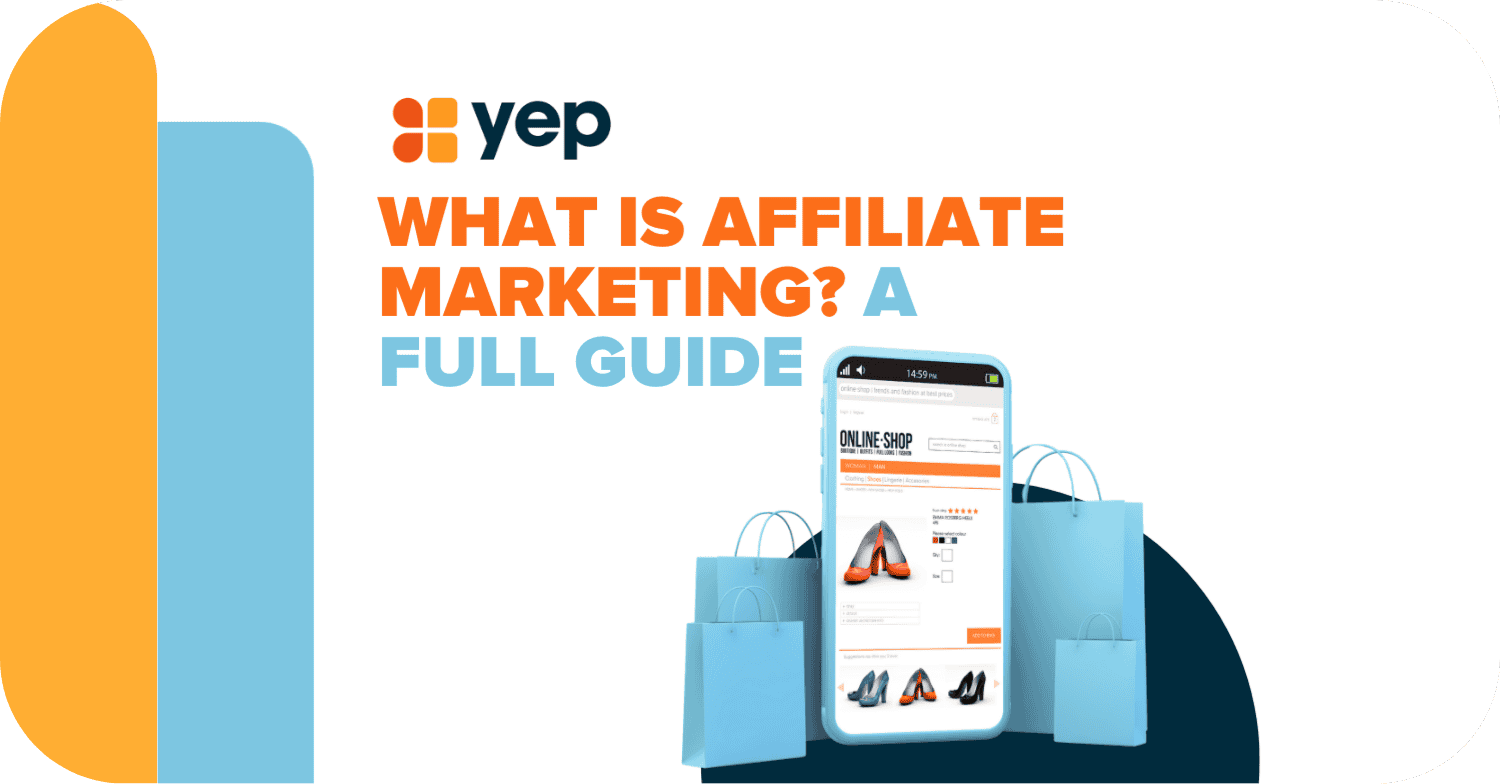
What Is Affiliate Marketing? A 2026 Full Guide
Affiliate marketing is shifting quickly. What worked last year might not cut it today, especially with AI, automation, and the rise of first-party data changing how brands and publishers operate. Let’s be honest—this space is evolving fast, but that means more opportunity for those who keep up.
Affiliate marketing is a performance-based marketing strategy where individuals or businesses promote another company’s products or services on a commission basis. Marketers (a.k.a. advertisers, Brands, Retailers, or Merchants) pay Affiliates (a.k.a. publishers or Partners) either directly or via a performance marketing network or agency when a specific action is completed, such as a sale, lead, or app install. Sound complex? Don’t worry—we’ll break it down into real-world language and examples.
Yep Ads has been at the forefront of performance marketing since 2009. As a global media agency, our mission is to help brands grow their business by harnessing data to find, engage, and convert customers efficiently. We do this through proprietary media channels, in-house technology, and KPI-driven analytics. Our cutting-edge platform supports over 500 million monthly clicks and offers automation, optimization, and reporting tools trusted by leading advertisers worldwide. The best part? You only pay when it works. Performance marketing done right is cost-effective, scalable, and smart.
This blog is your go-to guide to affiliate marketing in 2026. Whether you’re a brand growth manager, creator, affiliate marketer, or business owner, we’ll walk you through the essentials. You’ll learn how it works, why it matters, and how to get started. Expect insights, examples, and actionable tips you can apply today. You’ll walk away with real examples, tips you can apply today, and a clearer path to growing your revenue—no fluff.
Table of Contents
- What Is Affiliate Marketing?
- How Affiliate Marketing Works
- Why Affiliate Marketing Works in 2026
- Pros and Cons of Affiliate Marketing
- Why Work With an Affiliate Marketing Agency
- Popular Affiliate Verticals
- How Affiliate Marketers Make Money (and How Much) in 2026
- Payment Models Affiliate Marketers Will See in 2026
- What Affects How Much Affiliates Make
- How to Start Affiliate Marketing in 2026 (For Affiliates)
- How to Start Affiliate Marketing in 2026 (For Brands)
- Affiliate Marketing FAQ
- You Might Also Like
Key Highlights
- Affiliate Marketing is: A performance-based strategy where affiliates promote a brand’s products or services and earn commissions based on specific actions, such as sales or app installs.
- Growth of Affiliate Marketing: The industry is expected to reach $15.7B globally by the end of 2026, with 80% of brands running affiliate programs.
- Pros & Cons:
Pros include performance-based payments, scalability, and flexibility.
Cons include the need for compliance monitoring and affiliate fraud risks. - How to Start for Affiliates: Choose a platform and format, pick a vertical, join affiliate programs, and track performance.
- How to Start for Brands: Define clear goals, choose the right platform, build offers, recruit affiliates, and track performance to scale.
- Affiliate Marketing Agencies: Agencies like Yep Ads provide pre-vetted affiliates, advanced tracking, compliance management, and campaign optimization.
What Is Affiliate Marketing?
Affiliate marketing is a type of performance marketing where a brand (or advertiser) partners with affiliates (also known as publishers or creators) to promote its offers. Affiliates are only paid when a specific, agreed-upon action is completed, such as a product purchase (CPS), form submission (CPL), app install (CPI), etc..
Common CPA Models in 2026
- CPA – Cost per Action/Acquisition – Advertisers only pay partners (publishers or affiliates) when a new user is acquired or a specific action is completed. An action can be anything from a form fill, to a subscription, to a download to a purchase, etc., as agreed upon by the marketer.
- CPS – Cost per Sale – A pricing model that pays affiliates when a customer purchases a product or service at full cost, or via cash-on-delivery. With this model, the advertiser only pays when revenue is driven.
- CPL – Cost per Lead – This pricing model pays when a user has provided personal details as stipulated by the marketer. Common personal details collected include name, email, and/or zip code. With this model, lead generation is the desired goal.
- CPI – Cost per Install – Specific to mobile apps, this pricing model pays publishers when a user installs and opens an app. It is one of the most widely used models for mobile user acquisition campaigns.
How Affiliate Marketing Works
Affiliate marketing is built on partnerships and tracking. Brands offer unique links or codes to affiliates. When customers engage with those links—whether clicking an ad, filling out a form, or buying a product—the affiliate gets rewarded.
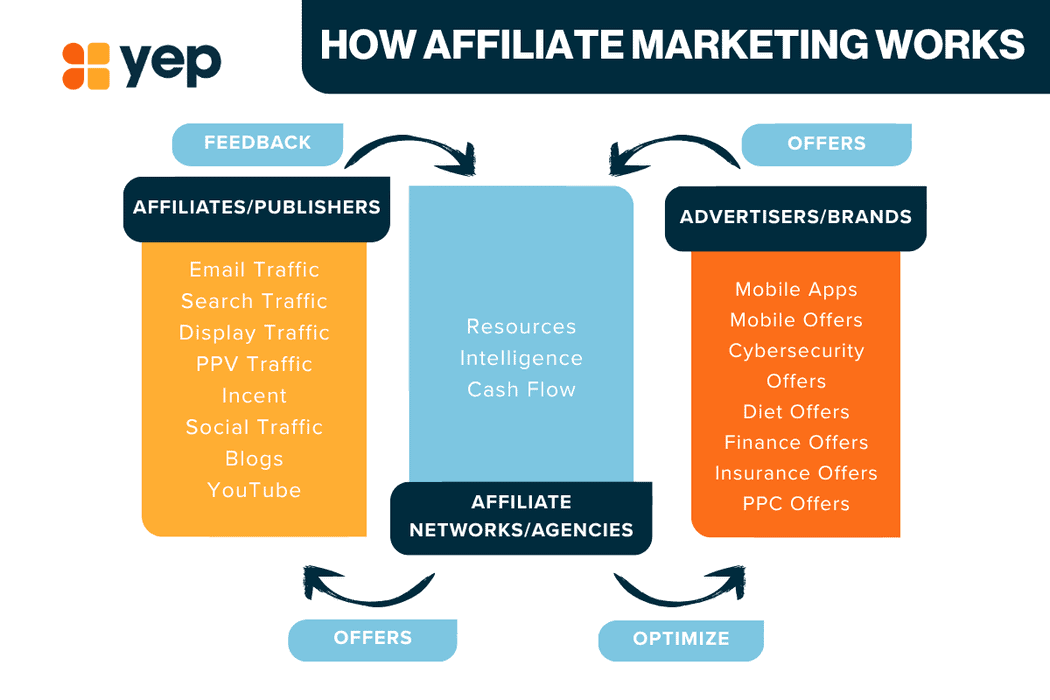
Image Source: Yep Ads Website
Key players include:
- Advertisers/Brands – Set performance goals (sales, leads), and scale results without upfront ad costs. Focus on ROI. Growth & Partnerships Teams: Build scalable acquisition channels through curated affiliate relationships.
- Affiliates/Publishers – (influencers, website owners, etc) promote products they trust and earn passive income via tracked links.
- Affiliate Networks/Agencies – Coordinate affiliate partnerships, ensure compliance, optimize creatives and funnels.
Tracking is typically done through cookies, server-to-server postbacks, or tracking platforms like Yep Ads.
Each affiliate is given a unique tracking link or code. When someone clicks on it and completes the desired action, the affiliate’s performance is recorded through backend platforms.
Here’s how the process works step-by-step:
1. An affiliate shares a tracked link or ad.
2. A user clicks the link.
3. The user completes an action (purchase, form fill, install).
4. The tracking platform logs the event.
5. The affiliate earns a commission.
Simple, right? And once you set it up, it works around the clock.
Affiliates are required to disclose their partnerships clearly. In the USA, the FTC mandates transparency (e.g., “I may earn a commission if you buy from this link.”).
It’s a win-win-win system: brands only pay for performance, affiliates monetize content, and consumers get relevant products or services.
Real-World Example
Let’s say a skincare brand partners with 50 wellness influencers. Each one shares a unique referral link for a new serum. For every purchase made via these links, the brand pays a $10 commission. No upfront ad spend, and the brand only pays for real conversions.
It’s efficient, scalable, and way less stressful than guessing which ads work
Why Affiliate Marketing Works in 2026
Here’s why affiliate marketing continues to win in 2026—especially if you want scalable, risk-free growth
- Risk-Free Scaling: Only pay for results
- Diversified Reach: Tap into niche and global audiences
- Trackable ROI: Transparent data from networks or platforms
- Flexible Models: Choose based on your goals (sales vs. leads vs. installs)
- Integrates With Everything: From Shopify to TikTok, affiliate tracking is now seamless
Pros and Cons of Affiliate Marketing
Pros:
- Performance-based: You only pay for results
- Scalable: Add affiliates and watch growth
- Flexible: You can adapt your programs based on performance, your business needs, and the market.
- Low-risk: Great for testing new markets
Cons:
- Requires compliance monitoring
- Affiliate fraud risk is if not managed well
- Takes time to find high-quality partners
Working with a trusted performance agency like Yep Ads can eliminate most of these challenges. We handle compliance, vetting, tracking, and optimization—so you can focus on growth while we take care of the heavy lifting.
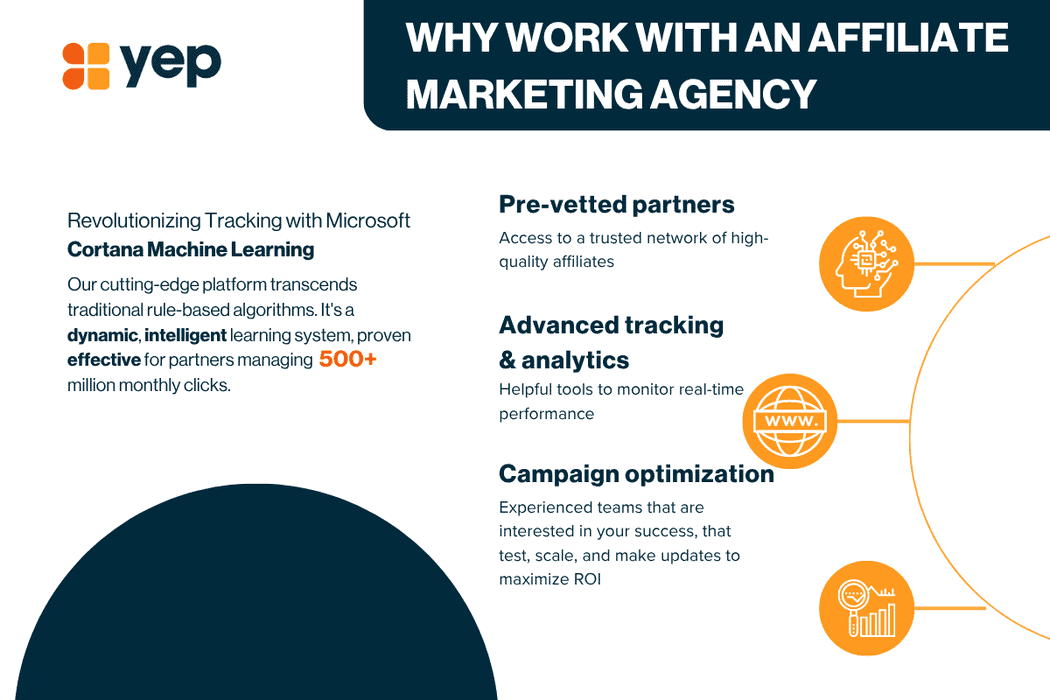
Image Source: Yep Ads Website
Why Work With an Affiliate Marketing Agency
Running an affiliate program in-house can be time-consuming and resource-heavy. An experienced performance marketing agency brings:
- Pre-vetted partners: Get access to a trusted agency of high-quality affiliates, and save time on researching, negotiating, and testing strategies.
- Advanced tracking & analytics: Affiliate agencies offer helpful tools to monitor real-time performance.
- Compliance management: Eliminate fraud and protect your brand.
- Campaign optimization: Experienced teams that are interested in your success, that test, scale, and make updates to maximize ROI.
Our difference at Yep Ads is that we go beyond just optimizing the campaign. With our creative marketing team in-house, we offer insights and can help with building creatives and landing pages that convert.
At Yep Ads, our mission is to help global brands grow faster and smarter. With over a decade of experience and industry-leading automation, our partners are receiving over 500+ million monthly clicks.

Image Source: Yep Ads Website
Popular Affiliate Verticals
Affiliate marketing is used in nearly every industry, but some verticals stand out for their performance, scalability, and affiliate adoption. Here’s a look at what’s trending across common verticals in the industry:
- eCommerce – Online retail, DTC brands, global stores
- Finance – Loans, credit cards, crypto platforms, banking apps
- Health & Wellness (Nutra) – Supplements, skincare, fitness products, CBD
- Education – Online courses, tutoring platforms
- Travel – Hotels, flight aggregators, tour bookings
- Cybersecurity – SaaS tools, hosting, antivirus, VPN
- Gaming – Online casinos, mobile games, fantasy sports
- Insurance – Auto, home, life, dental
- Home Services – HVAC, plumbing, cleaning services
- Sweepstakes & Lead Generation (known as cc trials) – Promo offers, survey sites, trials
How Affiliate Marketers Make Money (and How Much) in 2026
Whether you’re side-hustling or going all in, affiliate can be a powerful revenue stream. Affiliate marketers earn income by promoting offers through unique tracking links. When a user clicks that link and completes a specific action—like making a purchase or installing an app—the affiliate earns a commission.
According to Authority Hacker the average affiliate marketer earns $8,038 per month. Affiliate marketing is growing 10% YoY. Top-performing niches include Education, Travel, and Skincare/Beauty.
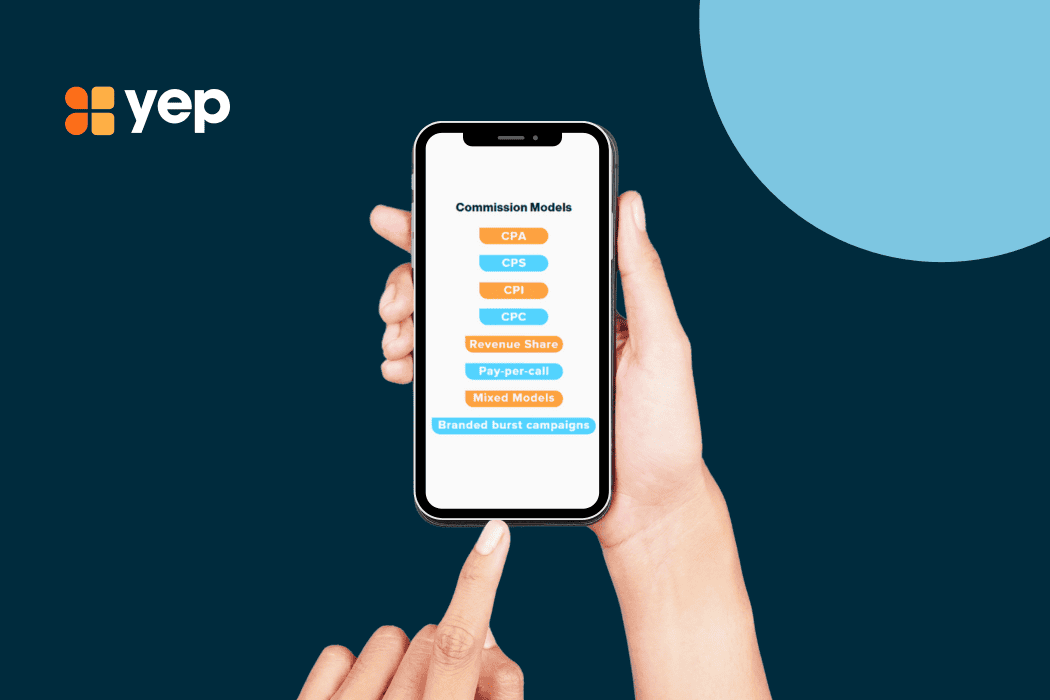
Image Source: Yep Ads Website
Payment Models Affiliate Marketers Will See in 2026
- CPA (Cost Per Action): You earn money when users complete actions like submitting a form, booking a call, or requesting a quote.
- CPS (Cost Per Sale): You get paid a percentage of each successful sale. This model is standard in retail and DTC brands.
- CPI (Cost Per Install): Common in the app space—you’re paid every time someone installs an app.
- Recurring Commissions: Earn ongoing income for subscription-based services like SaaS platforms.
- Hybrid/Tiered Models: Mix of CPA and revenue share, or commission rates that increase based on performance.
What Affects How Much Affiliates Make
Traffic Quality & Source: SEO, social media, email, or native ads
Traffic Quality stands for the engagement level and how many of the visitors actually make a purchase or take the desired action. Organic traffic from SEO usually converts well over time, while social media can deliver bursts of high engagement. Email marketing is often more targeted and leads to higher conversions, and native ads can scale performance if well-optimized. The better the quality of your traffic, the higher your potential earnings are.
Audience Trust: Niche audiences convert better
Affiliates who have built trust with a specific niche audience usually see better results. For example, if you are a mom and run an Instagram account about parenting, you will more likely have trust in terms of baby product recommendations. When your followers view you as a reliable source, they’re more likely to convert, especially if your content aligns closely with their needs and interests.
Offer Type: Trial-based, eComm, app installs—each has its rate
There are different rates for each offer type. For example, trial-based offers might pay less upfront but can lead to recurring income. As usually, there will be multiple events: 1. Sign up for the trial, 2. Purchasing the paid plan. Smart affiliates mix it up and test what performs best with their audience.
Vertical: Finance and education often pay more than general retail
Different verticals pay different rates, and it also depends on the brand. Often, industries like finance, insurance, and education offer higher payouts compared to general retail or lifestyle products due to higher customer value and competition.
Strategy: Diversification and consistency win over time
One of the goals for affiliates is to identify which traffic source works the best for the specific offers. But also in this industry, you have to test and try different strategies and channels to be ahead of the competition.The best affiliates treat this like a business, not a get-rich-quick scheme.
Bonus Tip: Don’t Rely on One Income Source
Affiliate income is powerful, but it can shift fast. Many top affiliates also:
- Sell digital products (ebooks, guides, courses)
- Offer sponsored posts or content bundles
- Build email lists or communities
- Monetize UGC or influencer partnerships
- Run display ads or test out paid traffic
Smart affiliates treat their work like a business—test, optimize, and grow from multiple directions.
How to Start Affiliate Marketing in 2026 (For Affiliates)
You don’t need a huge following. You just need the right niche and a smart approach.
If you have already built a following, own a blog, or know how to create viral content on Instagram or TikTok, you are a trusted expert, or overall have access to an audience, you should definitely consider becoming an affiliate.
If you’re ready to become an affiliate marketer in 2026, here’s a simple four-step plan to get started:
1. Choose Your Channel and Format
Decide how you want to reach your audience and what kind of content you’ll create.
Common Channels:
- Organic search (SEO)
- Email marketing
- YouTube
- Social: Facebook
Consider starting with the traffic channels you are already familiar with.
Start with the platform you’re already active on and understand well—this helps you sound more authentic and build trust faster.
Some of the content formats that convert are product reviews and demos, side-by-side comparisons, personal recommendations, or tutorials. Think of what would align best with your audience’s interests and consider partnering with these products or services. For example, if you do have a wellness blog or podcast, partnering with a wellness product can be a great idea. Your readers already trust your source for the topics related to health and wellness and will most likely be interested and grateful for the recommendation of a great product for their needs.
2. Pick a Vertical You Know or Want to Explore
Choose a niche that:
- Aligns with your interests or expertise (e.g., skincare, budgeting apps, pet care)
- Has a clear product-market fit
- Matches audience demand or untapped opportunities
You can use tools like Google Trends or Reddit to understand what your potential audience is actively searching or talking about.
3. Join the Right Affiliate Program or Agency
Look for agencies that:
- Specialize in your vertical
- Offer strong payouts and good tracking tools
- Support your preferred payment models (CPA, revenue share, CPI)
Popular agencies include:
Yep Ads (exclusive offers, worldwide reach, in-house creative team, dedicated support)
Impact, Awin, FlexOffers, CJ, and more
You can also partner directly with brands, many have affiliate programs listed in their website footer. Think of the pros and cons of partnering with affiliate agencies and decide if this is better for your goals or if you prefer going direct.
4. Promote and Track
Start creating content around the products or services you’re promoting, and:
- Use your unique affiliate links (with tracking)
- Monitor clicks, conversions, and ROI
- Test what content or traffic source performs best
- Optimize your funnel and scale
Affiliate success doesn’t come overnight, but with consistency, you can create a reliable revenue stream that grows over time. Join Yep Ads to access exclusive offers and personalized growth opportunities. Trusted by over 30K partners, we can help you with everything, starting with affiliate link creation and optimizing your funnel and scale, to finding more and more exclusive offers.
How to Start Affiliate Marketing in 2026 (For Brands)
Launching a performance marketing channel can unlock scalable growth for your business. Here’s how to start:
1. Set Clear Goals and KPIs
What do you actually want from your affiliate program? More sales? More app installs? A flood of new leads?
Start with clear objectives:
- Define KPIs like CPA targets, ROAS, or conversion rate
- Set your budget and align with internal teams on goals.
2. Pick the Right Affiliate Platform or Partner
You’ve got options here:
- Use a self-serve platform
- Work with a performance marketing agency like Yep Ads (we handle everything from recruitment to optimization).
3. Build a High-Converting Offer & Funnel
Decide what you want affiliates to promote:
- One-time products or subscriptions?
- High-volume lead gen or niche services?
Make sure your landers, creatives, and conversion flows are optimized for user experience. Need help with this? Work with an agency like Yep Ads, which has a creative in-house studio to help build out creatives based on market research and top-performing ads.
4. Launch, Track, and Scale
Once your offer and tracking are ready:
- Recruit affiliates in your niche
- Launch creatives and monitor performance
- Use real-time data to optimize your campaigns
Whether you’re a brand looking to scale performance or a creator ready to monetize your audience, Yep Ads makes affiliate marketing smarter, faster, and more profitable. Let’s build something high-converting together. Contact us to get exclusive offers and join a network trusted by 30,000+ partners worldwide
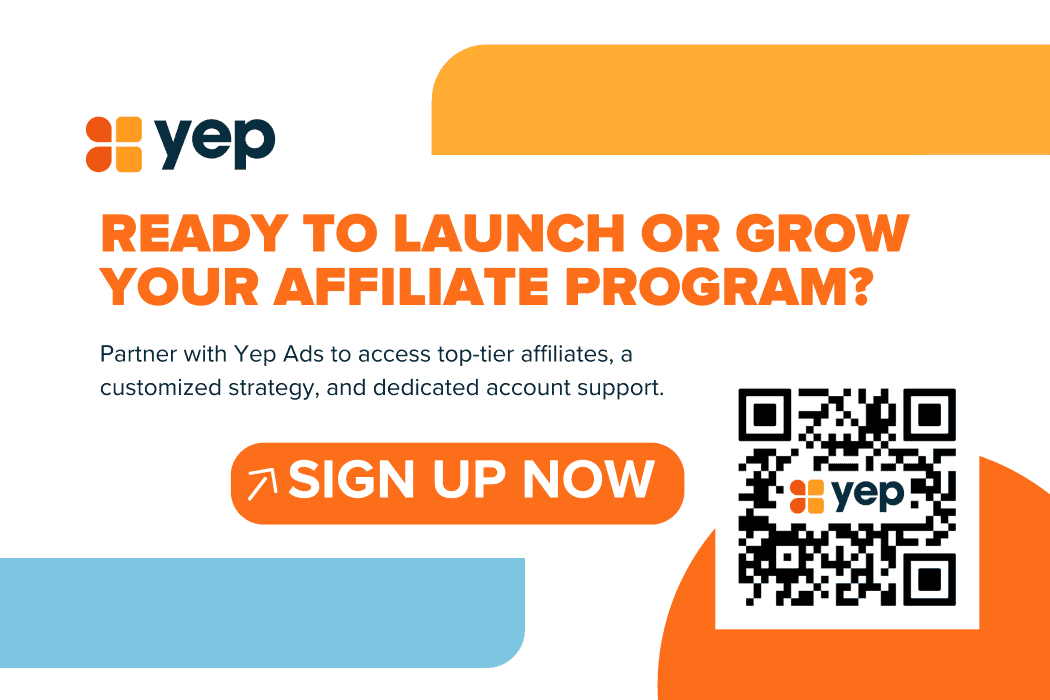
Image Source: Yep Ads Website
Affiliate Marketing FAQ
What is the difference between affiliate marketing and influencer marketing?
Affiliate marketing is performance-based, with commissions tied to results. Influencer marketing often focuses on brand awareness and may involve flat fees.
Do I need a large audience to become an affiliate?
No. Niche audiences often perform best. Focus on quality, not quantity.
Can businesses use both in-house and agency-managed affiliate programs?
Yes. Many enterprise brands use a hybrid approach to scale efficiently.
What is the best commission model in 2026?
CPA (Cost Per Action) remains the most flexible and widely used across verticals.
What tools help with affiliate program management?
An agency like Yep Ads can help manage and optimize an affiliate program. By partnering with us, you will have access to our AI-driven platform and the latest tools built to track and scale each offer that you have.
You Might Also Like
- Performance Marketing vs Digital Marketing: Which One Drives Results?
- How to Scale Affiliate Marketing the Smart Way
- How to Grow an Affiliate Marketing Campaign Using 3 Proven Strategies
